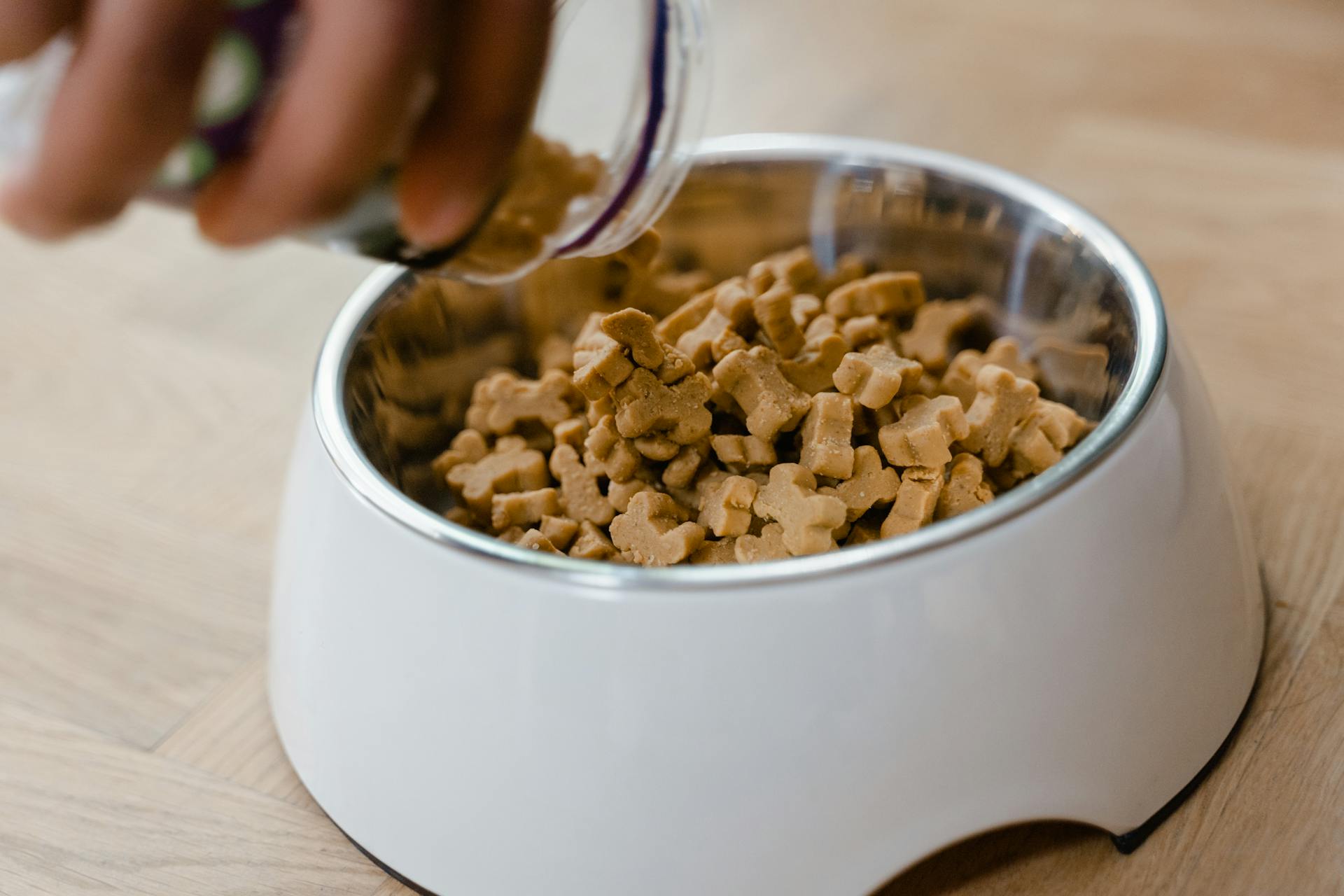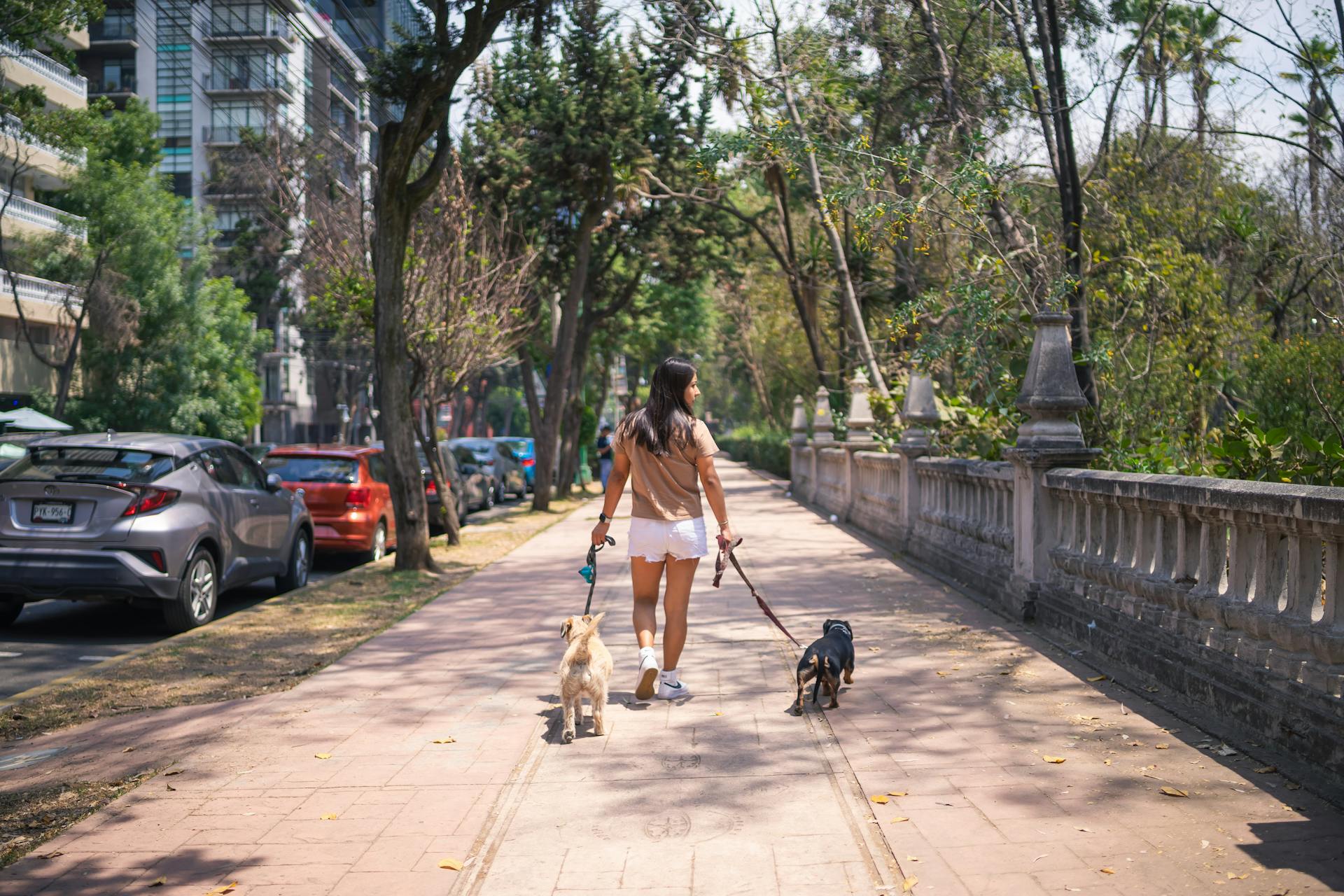
As a dog owner, you want to make sure your furry friend is getting the right amount of food at the right time. Puppies, adults, and seniors all have different needs, and a well-planned food schedule can make a big difference in their health and happiness.
Puppies, for example, need to eat more frequently than adults, with 3-4 meals per day until they're about six months old. This helps them grow and develop properly.
Adult dogs, on the other hand, can thrive on two meals per day, with a balanced diet that meets their individual needs. For example, a 10-pound dog may need 1/4 to 1/2 cup of food per meal.
Seniors, especially those over the age of 7, may benefit from a more gradual feeding schedule, with 2-3 smaller meals per day. This can help manage weight and prevent digestive issues.
A unique perspective: Dog Grooming Schedule
Puppy Nutrition
Puppy Nutrition is a crucial aspect of raising a healthy and happy pup. Your puppy's diet should be AAFCO approved for their life stage, whether they're a puppy, adult, or pregnant/lactating.
Dogs need a specific amount of food based on their age, health status, and activity level. A feeding guide is usually provided on the food packaging, but remember, it's just a guide and may need to be adjusted as your puppy grows.
Use a body condition score chart to determine if your dog is over or under-nourished. This will help you make informed decisions about their diet.
Dogs are given puppy food, which contains more calories than adult food and essential vitamins and minerals. This food is designed for their developing bodies until they reach around 90% of their full adult body weight.
A feeding schedule can help with toilet training by ensuring you're ready to take your puppy outside when they need to poop. Generally, a young puppy will need to poop about 15 minutes after eating.
Here's a rough guide to follow for a puppy feeding schedule:
Adult Dog Nutrition
Adult dogs have unique nutritional needs that vary depending on their age, health status, and activity level. You'll want to choose a high-quality dog food that's AAFCO approved for your pet's life stage, whether they're an adult, puppy, or pregnant/lactating.
A good starting point is to follow the feeding guide on the food label, but keep in mind that this is just a guide, and you may need to make adjustments based on your dog's individual needs.
Adult dogs tend to do best when their daily food allowance is split between two meals, but three meals a day can also work. Here's a sample feeding schedule:
Remember, every dog is different, and you may need to adjust this schedule based on your pet's individual needs and activity level.
Senior Dog Nutrition
As dogs age, their nutritional needs change, and senior dogs can benefit from a more tailored approach to feeding.
Senior dogs can be fed on the same schedule as adult dogs, but some do better with smaller meals fed more frequently.
General Guidelines
Dogs need food that's right for their age, health, and activity level. Look for AAFCO-approved foods that give a feeding guide, but remember it's just a guide and you may need to adjust the amount based on your dog's condition.
A quality bag of dog food is essential, but it's not the only factor to consider. You should also think about the amount of exercise your dog gets, their weight, metabolic rate, number of meals per day, and type of food. These factors will determine the right amount of food for your dog.
To determine the right amount of food, you can use a dog feeding chart, which takes into account your dog's weight and age. For example, a puppy's age and weight will determine how much food they need. Here's a rough guide to get you started:
Remember, this is just a starting point, and you may need to adjust the amount based on your dog's individual needs.
Daily Routines for Pet Owners
Having a daily routine for your dog is essential to building a strong bond and ensuring their basic needs are met. Dogs thrive on predictability and schedules.
Establishing a daily routine helps new dog owners ensure their pup's needs are met on a daily basis. Every dog is unique, so there isn't a standard schedule that works for all dogs.
You'll need to consider your own lifestyle and be honest about what you can consistently provide for your pup. It's essential to understand basic dog walking safety tips.
A feeding schedule is also crucial. Most dogs should eat twice a day, roughly 12 hours apart. Younger and/or smaller pups might need lunch to keep their metabolism in balance.
Mealtimes should be spaced out to prevent hunger and accidents outside. Young puppies will need to go to the bathroom shortly after eating.
You'll need to consider timing meals around walks and playtime. Feeding your dog right before bed or intense exercise should be avoided, as it can lead to bloat in deep-chested large dogs.
Here are some factors to consider when determining the best food for your dog:
- Age: Puppies need puppy food, while senior dogs benefit from senior formulas.
- Weight: Consult your veterinarian to determine the right diet for a healthy weight loss or gain.
- Activity Level: More energetic dogs may require calorie-heavy food, while less active dogs may require less.
To determine the right amount of food for your dog, consider factors like exercise, weight, metabolic rate, number of meals per day, and type of food.
Nutrition Guidelines
If you're wondering how much to feed your dog, it's essential to consider their age, health status, and activity level. Generally, you'll want to look for AAFCO-approved food that matches your pet's life stage, whether they're an adult, puppy, or pregnant/lactating.
The amount of food your dog needs depends on several factors, including their breed, age, and daily activity level. There is no one-size-fits-all answer, but rather a range of daily calories based on these factors.
For example, extra-small dogs (5-10 pounds) need around 160-200 daily calories, while small-medium dogs (10-30 pounds) require 320-480 daily calories. Medium-large dogs (30-50 pounds) need 640-800 daily calories, and large dogs (50-70 pounds) need 960-1120 daily calories.
You can also use a body condition score chart to determine if your dog is over or under-nourished. If you're unsure, you can consult with a vet online through services like PangoVet.
To calculate dog food portions by weight and breed, you can use a dog feeding chart, which provides recommendations based on breed type and size. Remember to adjust for age as well, as puppies need more food per pound than older dogs.
You might like: Vet Approved Homemade Dog Food Recipes for Large Dogs

Here's a rough guide to dog food portions by weight:
Remember, these are just guidelines, and you should adjust the amount based on your dog's individual needs and activity level.
Natural Diet with Darwin
Choosing a natural diet for your dog is a great way to support their overall health and well-being. No matter how much or how often you need to feed your dog, this choice is so important.
At Darwin's Natural Pet Products, you can find affordable, high-quality raw pet food that's inspired by nature and informed by science. They've formulated all of their products with your pet in mind.
Making the switch to holistic, natural, and hormone-free raw dog food can be a great decision for your dog's health.
Recommended read: Natural Balance Dog Food Making Dogs Sick
Feeding Schedule
Feeding your dog a scheduled meal plan is generally better than free feeding, as it allows you to monitor their intake and prevent overeating.
Most veterinarians recommend feeding your dog twice a day, but if your dog is overweight, smaller portions throughout the day might be more suitable. This can help keep them feeling full without a spike in insulin.
Intriguing read: How Many Treats a Day for a Dog
You can divide the daily amount of food listed on the dog food chart by the number of meals your pup needs in a 24-hour period to determine the correct serving size for each meal.
For example, if your dog needs three meals a day, you can divide the daily amount of food by 3. Here's a sample feeding chart to give you an idea of general guidelines:
Remember to consult with your veterinarian to determine the best feeding schedule for your dog based on their age, size, and health status.
Consider Their
Most vets recommend feeding your dog twice daily, as we mentioned earlier.
Free feeding can lead to resource guarding if your dog feels they need to protect the food that is always in their bowl.
If your dog is overweight, smaller portions throughout the day might actually help, keeping your pup feeling full without a spike in insulin.
Check with your vet for the correct way to go about this for your dog.
You can divide the serving size listed in the dog feeding chart by the number of meals your pup needs in a 24-hour period to understand how much to serve per meal.
Here's a general guideline for adult dogs:
- For an adult dog between 3 to 6 lbs. – ⅓ to ½ cup of food per serving
- For an adult dog between 10 to 20 lbs. – ¾ to 1 ⅓ cups of food per serving
- For an adult dog between 30 to 50 lbs. – 1 ¾ to 2 ⅔ cups of food per serving
- For an adult dog between 60 to 100 lbs. – 3 to 4 ½ cups of food per serving
- For an adult dog over 100 lbs. – 4 ½ cups plus ¼ cup for every additional 10 lbs.
Consistency is key, so base the feeding times on your schedule and try to coordinate with your own meals.
Slow Bowl
If your dog inhales their food the minute you put it down, consider buying a special dish designed to slow them down as they eat.
Using a slow feeder dog bowl can help your dog eat at a slower pace, which is great for their digestion and reduces the chances that they will get bloated, choke, or vomit after eating.
Forcing your dog to eat at a slower pace can also prompt them to chew their food more, and some dogs may even eat less because they'll feel full before they finish their food.
Feeding your dog three to four times a day with a slow feeder can help them feel full throughout the day and have more time to digest and chew their food.
For more insights, see: Do Dogs Chew Their Food
Sources
- https://www.thesprucepets.com/puppy-food-feeding-schedule-2804779
- https://www.darwinspet.com/blog/blog--feeding-chart-for-dogs-a-complete-guide.html
- https://www.petplate.com/blog/weight-loss-feeding-charts/
- https://www.dogster.com/dog-nutrition/dog-feeding-schedule
- https://www.jordanspetcare.com/blog/daily-schedule-for-dogs
Featured Images: pexels.com


